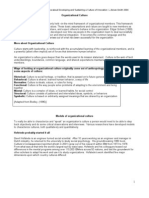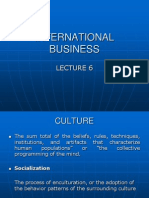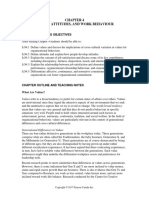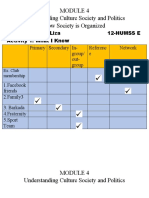0 ratings0% found this document useful (0 votes)
45 viewsChapter 2 Understanding Cross-Cultural Management Dimensions
Chapter 2 Understanding Cross-Cultural Management Dimensions
Uploaded by
ziadiub007Copyright:
Attribution Non-Commercial (BY-NC)
Available Formats
Download as PPT, PDF, TXT or read online from Scribd
Chapter 2 Understanding Cross-Cultural Management Dimensions
Chapter 2 Understanding Cross-Cultural Management Dimensions
Uploaded by
ziadiub0070 ratings0% found this document useful (0 votes)
45 views22 pagesOriginal Title
ch02_Cross-Cultural Management Dimensions
Copyright
© Attribution Non-Commercial (BY-NC)
Available Formats
PPT, PDF, TXT or read online from Scribd
Share this document
Did you find this document useful?
Is this content inappropriate?
Copyright:
Attribution Non-Commercial (BY-NC)
Available Formats
Download as PPT, PDF, TXT or read online from Scribd
Download as ppt, pdf, or txt
0 ratings0% found this document useful (0 votes)
45 views22 pagesChapter 2 Understanding Cross-Cultural Management Dimensions
Chapter 2 Understanding Cross-Cultural Management Dimensions
Uploaded by
ziadiub007Copyright:
Attribution Non-Commercial (BY-NC)
Available Formats
Download as PPT, PDF, TXT or read online from Scribd
Download as ppt, pdf, or txt
You are on page 1of 22
Chapter 2 Understanding
Cross-Cultural
Management Dimensions
Managing Organizations in a Global
Economy: An Intercultural Perspective
First Edition
John Saee
Copyright by South-Western, a division of Thomson Learning. All rights reserved.
Global Strategy and Culture
To succeed, corporations must develop
global strategies. Recent decades saw
the growing importance of global
strategies, at least among leading firms
and management scholars; however, the
new millenium made it imperative
(Adler 1997).
Cross–Cultural Management
Cross–Cultural Management
The growing importance of world
business has created a demand for
managers sophisticated in global
management skills and working with
people from other countries.
Cross–cultural management describes
organizational behavior within countries
and cultures; compares organizational
behavior across countries and cultures;
and seeks to understand how to improve
the interaction of co–workers, managers,
executives, clients, suppliers, and
alliance partners from around the world.
Global versus Domestic Organizations
Two fundamental differences between
global and domestic organization are
geographic dispersion and
multiculturalism.
Multiculturalism means that people from
many cultures interact regularly.
What Is Culture?
To understand the differences between
domestic and global management, it is
necessary to understand the primary ways
in which cultures around the world vary.
Culture is:
Something that is shared by all or almost
all members of some social group.
Something that the older members of the
group try to pass on to the younger
members.
Something that shapes behavior or
structures one’s perceptions of the world.
Cultural Orientations
The cultural orientation of the
society reflects the complex
interaction of values, attitudes, and
behaviors displayed by its members.
Individuals express culture and its
normative qualities through the
values that they hold about life and
the world around them (Adler 1997)
How Do Cultures Vary
As shown in Table 1, six basic dimensions
describe the cultural orientation of
societies: people’s qualities as individuals,
their relationship to nature and the world,
their relationship to other people, their
primary type of activity, and their
orientation in space and time.
Individual Dimensions
The following dimensions answer the
questions
Who am I?
How do I see the world?
How do I relate to other people?
What do I do?
How do I use space and time?
How People See Themselves
People’s Relationship to the World
What is a person’s relationship to the
world? Are people dominant over their
environment, in harmony with it, or
subjugated by it?
Personal Relationships: Individualism
or Collectivism
Activity: Doing or Being
North Americans generally see
themselves as dominant over nature.
Other societies, such as Chinese and
Japanese, attempt to live in harmony
with nature. They see no real
separation between people and their
natural environment.
Table 3: Comparative Work Goals: German, Japanese, and
American Respondents’ Rankings
Work goals Germany Japan USA
Interesting work 3 2 1
Good pay 1 5 2
Good interpersonal
relations 4 6 7
Good job security 2 4 3
A good match between you
and your job 5 1 4
A lot of autonomy 8 3 8
Opportunity to learn 9 7 5
A lot variety 6 9 6
Convenient work hours 6 8 9
Good physical working
conditions 11 10 11
Promotion 10 11 10
Source: England (1986, P. 181)
In another international study of
management–performance appraisals
in the U.S.A., Saudi Arabia, and Japan
conducted by Harris and Moran
(1991), it was found that performance
appraisal differed significantly across
cultures.
A seminal research by Hofstede (1980)
went further in showing how the
underlying values of the cultures
across the world permeate through to
affect relationships, work, and social
values.
Hofstede (1980) undertook a
comprehensive study on worldwide
sociocultural factors influencing
management. Hofstede’s research
compared work–related attitudes across
a range of cultures. From his survey of
116,000 employees in 40 countries,
Hofstede isolated 4 major dimensions
which were congruent with different
cultural values of specific countries.
These socio–cultural factors were:
1.Collectivism vs. Individualism
2.Small vs. Large Power Distance
3.Weak vs. Strong Uncertainty Avoidance
4.Femininity vs. Masculinity
Fifth Cultural Dimension
Hofstede, in collaboration with Bond
(1984), identified an additional cultural
dimension by which nations can be
classified: Confucian Dynamism.
Confucian Dynamism is also referred
to as Long Term Orientation vs. Short
Term Orientation.
Confucianism is not a religion, but a
system of practical ethics prevalent in
China.
The five basic relationships are:
Ruler–subject
Father–son
Older brother–younger brother
Husband–wife
Older friend–younger friend.
Harmony in the family must be
preserved, and harmony is the
maintenance of one’s face, that is, one’s
dignity, self respect, and prestige.
Treating others as one would like to be
treated oneself is virtuous behavior.
Skills for Effective Cross-Cultural Management
Respect.
Tolerating ambiguity.
Relating to people
Being nonjudgmental
Personalizing one’s observations.
Empathy—the ability to “put yourself in
another’s shoes.”
Persistence.
You might also like
- EIOP 1524 Assignment 2 (2020509663)Document7 pagesEIOP 1524 Assignment 2 (2020509663)mohapisthaba77No ratings yet
- Pearl Diving Assignment 1Document9 pagesPearl Diving Assignment 1api-611145965No ratings yet
- CultureDocument5 pagesCultureapi-3747057100% (2)
- Domestic Violence PresentationDocument6 pagesDomestic Violence Presentationapi-359543029No ratings yet
- Cross CultureDocument34 pagesCross CultureSnega Latha100% (2)
- Cross Cultural ManagementDocument49 pagesCross Cultural Managementbharatikumar100% (1)
- Chapter 2 Understanding Cross-Cultural Management DimensionsDocument34 pagesChapter 2 Understanding Cross-Cultural Management DimensionsVandana KaushikNo ratings yet
- Submitted By: Jugraj Singh BTM 4th SemDocument71 pagesSubmitted By: Jugraj Singh BTM 4th SemJD VirkNo ratings yet
- Chapter 2 - The Meanings and Dimensions of CultureDocument56 pagesChapter 2 - The Meanings and Dimensions of CultureHuyen ThuNo ratings yet
- Lecture 3 Cultural EnvironmentsDocument37 pagesLecture 3 Cultural Environments22002239No ratings yet
- Unit 17 Cross Cultural Dynamics: All People Are The Same. It S Only Their Habits That Are So Different. ConfuciusDocument17 pagesUnit 17 Cross Cultural Dynamics: All People Are The Same. It S Only Their Habits That Are So Different. ConfuciusRajendran ArulNo ratings yet
- Week 5 - IHRM and CultureDocument21 pagesWeek 5 - IHRM and CultureRaman Shanmuga100% (1)
- Topic 5 - Overview USWDocument23 pagesTopic 5 - Overview USWDominic Nsikan JohnNo ratings yet
- Title: "The Scope of Cultural Dimensions in Contemporary Global Leadership Practices - A Study"Document12 pagesTitle: "The Scope of Cultural Dimensions in Contemporary Global Leadership Practices - A Study"komalNo ratings yet
- ICC PresentationDocument48 pagesICC PresentationmuneerppNo ratings yet
- IntoManagement - 5 LectureDocument19 pagesIntoManagement - 5 LectureNurt TurdNo ratings yet
- 1513918980Module8Q1 Paper6 CrossCulturalManagementDocument8 pages1513918980Module8Q1 Paper6 CrossCulturalManagementmohittripathi296No ratings yet
- Lecture 6Document46 pagesLecture 6Sara IjazNo ratings yet
- Cross-Cultural Management 2Document54 pagesCross-Cultural Management 2Raman GhaiNo ratings yet
- Nancy J. Adler - Cross Cultural Management - Issues To Be FacedDocument40 pagesNancy J. Adler - Cross Cultural Management - Issues To Be Facedcjcp04No ratings yet
- International Business: Unit: IIDocument50 pagesInternational Business: Unit: IIMitali PatelNo ratings yet
- What Is It About? Comparative ManagementDocument42 pagesWhat Is It About? Comparative Management0999593121No ratings yet
- The Influence of Culture and Gender On NegotiationsDocument21 pagesThe Influence of Culture and Gender On Negotiationsshiv kumarNo ratings yet
- Cultural Dimension of ManagementDocument31 pagesCultural Dimension of ManagementsurangauorNo ratings yet
- Chapter 2 - Globalization, Diversity and EthicsDocument10 pagesChapter 2 - Globalization, Diversity and EthicsPhee JhayNo ratings yet
- The Leader's Guide To Corporate CultureDocument15 pagesThe Leader's Guide To Corporate CultureSyed Abu HurairaNo ratings yet
- Comparative ManagementDocument8 pagesComparative ManagementHindolo MassallayNo ratings yet
- Notes For Class 1Document8 pagesNotes For Class 1266818No ratings yet
- Chapter 2 - Globalization, Diversity and EthicsDocument12 pagesChapter 2 - Globalization, Diversity and EthicsTrixxie mae MontelloNo ratings yet
- Cultural DimensionsDocument57 pagesCultural DimensionsAbhijeet ChauhanNo ratings yet
- Johns 10e Irm ch04 PDFDocument22 pagesJohns 10e Irm ch04 PDFJacob WeiseNo ratings yet
- VIII Managing Across Culture IssuesDocument24 pagesVIII Managing Across Culture IssuesamritabhosleNo ratings yet
- Diversity EducationDocument18 pagesDiversity EducationTrish100% (9)
- Culture DucDocument25 pagesCulture DucaducNo ratings yet
- Cross Cultural ManagementDocument54 pagesCross Cultural ManagementSoham Savjani100% (1)
- Full Summary For Exam (Book + Articles)Document120 pagesFull Summary For Exam (Book + Articles)irem anNo ratings yet
- Differences in Culture: INB 372 Lecture By: Ms. Adina Malik (ALK)Document22 pagesDifferences in Culture: INB 372 Lecture By: Ms. Adina Malik (ALK)Tuly MazumderNo ratings yet
- The Meanings and Dimensions of CultureDocument26 pagesThe Meanings and Dimensions of CultureGagan PreetNo ratings yet
- Unit I: International Cultural EnvironmentDocument53 pagesUnit I: International Cultural EnvironmentAnuja BhakuniNo ratings yet
- Human & Cultural VariablesDocument5 pagesHuman & Cultural VariablesAbhi JainNo ratings yet
- Cross Cultural ManagementDocument22 pagesCross Cultural ManagementSalman Ghauri100% (1)
- Johns 10e Irm ch04Document22 pagesJohns 10e Irm ch04Jacob WeiseNo ratings yet
- Chapter 03 - Differences in Culture - Charles W. L. Hill 9e - PPTDocument23 pagesChapter 03 - Differences in Culture - Charles W. L. Hill 9e - PPTshoaib100% (2)
- The Importance of Understanding Culture in International BusinessDocument5 pagesThe Importance of Understanding Culture in International BusinesswaqasrehmanNo ratings yet
- Cross Cultural ManagementDocument21 pagesCross Cultural ManagementGaetanoNo ratings yet
- OB (Organisational Culture-Lecture 1)Document12 pagesOB (Organisational Culture-Lecture 1)winiko ziwoyaNo ratings yet
- Huma IN G: N & Cultural Variables Lobal OrganizationDocument25 pagesHuma IN G: N & Cultural Variables Lobal OrganizationAnshu TyagiNo ratings yet
- Effect of Culture On Entrepreneurship in NigeriaDocument6 pagesEffect of Culture On Entrepreneurship in NigeriainventionjournalsNo ratings yet
- Cross Cultural MCDocument12 pagesCross Cultural MCask123.grindeNo ratings yet
- 5 Culture Differences in LeadershipDocument16 pages5 Culture Differences in LeadershipAbu Ahmed ShahibNo ratings yet
- Lecture 3Document33 pagesLecture 3RegNo ratings yet
- Entrepreneurship: What Triggers It?: Alison MorrisonDocument13 pagesEntrepreneurship: What Triggers It?: Alison MorrisonAyesha MughalNo ratings yet
- Hofstede, Geert Management Scientists Are HumanDocument11 pagesHofstede, Geert Management Scientists Are HumanAlifah DinaNo ratings yet
- Lecture 3 Context For Global HRM - National CultureDocument33 pagesLecture 3 Context For Global HRM - National Culture郑以No ratings yet
- CultureDocument41 pagesCulture夜晨曦No ratings yet
- Managing Across CulturesDocument8 pagesManaging Across Culturescrazzychaps1987No ratings yet
- BMT-Hofstede S Cultural DimensionsDocument6 pagesBMT-Hofstede S Cultural DimensionsadhityakinnoNo ratings yet
- Week 4 Intercultural CommunicationDocument48 pagesWeek 4 Intercultural CommunicationPopescu VioricaNo ratings yet
- MidtermDocument26 pagesMidtermNicole Grace AlladoNo ratings yet
- Does Culture Matter in Competence Management?: Transforming Barriers to EnablersFrom EverandDoes Culture Matter in Competence Management?: Transforming Barriers to EnablersNo ratings yet
- Oxford Happiness Questionnaire 2016Document3 pagesOxford Happiness Questionnaire 2016shuaib jamilNo ratings yet
- Summary Birkinshaw, J., Gudka, M., & D'Amato, V. (2021)Document2 pagesSummary Birkinshaw, J., Gudka, M., & D'Amato, V. (2021)benjaminbollens2023No ratings yet
- Giáo Án Unit 9 - Looking Back L P 11Document38 pagesGiáo Án Unit 9 - Looking Back L P 11hana153201No ratings yet
- Polsci Module3Document7 pagesPolsci Module3Janice Dano OnaNo ratings yet
- Makalah Bahasa InggrisDocument10 pagesMakalah Bahasa InggrisSimon WaruwuNo ratings yet
- Lesson 2 Management Competencies and Why They Matter PDFDocument39 pagesLesson 2 Management Competencies and Why They Matter PDFwani100% (1)
- DocxDocument3 pagesDocxAliyah SangsterNo ratings yet
- Adult Children of Divorce - HughesDocument19 pagesAdult Children of Divorce - Hughesmarcio100% (1)
- Parenting StylesDocument21 pagesParenting StylesmoonhchoiNo ratings yet
- Techniques of Feminist TherapyDocument5 pagesTechniques of Feminist TherapyAKANKSHA SUJIT CHANDODE PSYCHOLOGY-CLINICALNo ratings yet
- Lesson 3 Symbolic Interaction TheoryDocument15 pagesLesson 3 Symbolic Interaction TheoryThiviya RameshNo ratings yet
- How To Create Healthy BoundariesDocument3 pagesHow To Create Healthy BoundariesMarie Mamat100% (3)
- 6 Thinking HatsDocument3 pages6 Thinking HatsGrace Joy MarcelinoNo ratings yet
- 12 Do's and Don'ts For Stopping Bullying - Psychology TodayDocument16 pages12 Do's and Don'ts For Stopping Bullying - Psychology TodayMax ZuhaediNo ratings yet
- Definition of Personality: A Relatively Stable Set of Characteristics That Influences An Individual's BehaviorDocument47 pagesDefinition of Personality: A Relatively Stable Set of Characteristics That Influences An Individual's BehaviorpulkitNo ratings yet
- Social PsychologyDocument17 pagesSocial PsychologyimtiazNo ratings yet
- Consumer AttitudeDocument25 pagesConsumer AttitudeChetal Bhole0% (1)
- HW 1 (T.o.p) - Case Studies 1 and 2Document3 pagesHW 1 (T.o.p) - Case Studies 1 and 2decastroghislaneNo ratings yet
- Marriage CounselingDocument17 pagesMarriage CounselingMuzamil100% (1)
- IJRSML 2021 Vol09 Issue 9 Eng 03Document6 pagesIJRSML 2021 Vol09 Issue 9 Eng 03Prakash MangaloreNo ratings yet
- Introvert, Extrovert and Ambivert: September 2019Document5 pagesIntrovert, Extrovert and Ambivert: September 2019Trifan DamianNo ratings yet
- Understanding Culture Society and Politics How Society Is OrganizedDocument7 pagesUnderstanding Culture Society and Politics How Society Is OrganizedSTEPHEN JAMES RONCESVALLES LIZANo ratings yet
- Detailed Lesson Plan in English For Grade 10Document4 pagesDetailed Lesson Plan in English For Grade 10Asrock LoopNo ratings yet
- How Schools Can Promote The Intercultural Competence of Young PeopleDocument13 pagesHow Schools Can Promote The Intercultural Competence of Young PeopleJulia Marcelly FellerNo ratings yet
- Abcdefghijk (Fuck L) MnopqrstuvwxyzDocument14 pagesAbcdefghijk (Fuck L) MnopqrstuvwxyzRonel PanchooNo ratings yet
- Cultural Dimensions Assessment Revised r2 102219 1Document5 pagesCultural Dimensions Assessment Revised r2 102219 1api-561601258No ratings yet
- Avolio Walumba and Weber - 2009 - Leadership Current Theories Research and Future DirectionsDocument32 pagesAvolio Walumba and Weber - 2009 - Leadership Current Theories Research and Future DirectionsbiaNo ratings yet

























































































